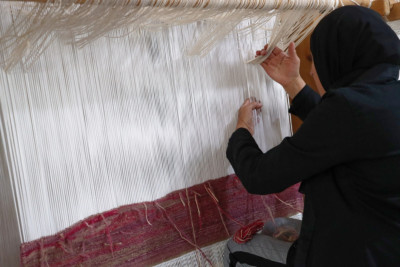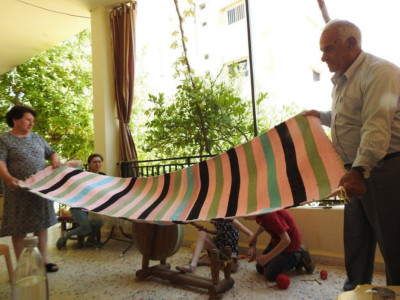Rugs weaving

The history of rug making exemplifies the transmission of intangible cultural heritage elements within a community and across different regions. This know-how originated in Aidamoun, a village in Akkar known for its population of Turkish origin who brought their weaving skills with them when they settled in this region of northern Lebanon. The skill was transferred to Al-Fekha in the Bekaa by a woman from northern Lebanon who married in the aforementioned town. There, the skill became widespread. The majority of Ersal’s inhabitants owned flocks of sheep that provided them with good wool for making rugs, and they used to travel to Al-Fekha either to resell that wool to rug workshops or to order rugs to decorate their homes. In the early 1960s, one of Ersal’s daughters took the initiative to learn this craft in Fekha and bring it back to her village, which led to the spread of looms in homes in the area.
Carpet weaving is a rather complex craft that involves multiple stages. It begins with the preparation of the wool, which includes washing and cleaning it, then dyeing it (a time-consuming and laborious process), spinning it, and transforming it into usable yarn. Patterns, colors, and inscriptions vary according to the customer’s taste.
After the golden age of rug weaving in the 1970s and 1980s, the craft has declined considerably. Revitalization efforts have transformed it from a traditional home-based craft to a workshop run by an association. Over ten women are involved, along with a few others who weave rugs at home. The knowledge and skills involved in weaving, which were once passed down from mother to daughter in the domestic sphere, are now passed on through training sessions held at the association’s premises for those who wish to learn the trade. The production of Arab rugs, characterized by their pure wool composition, long pile, and longevity of several decades if well cared for, has been replaced by kilims production. Designers propose new patterns and colors that guide the weaving process.
 Al-Qaa village in Hermel has his own history of carpet weaving. In weaving families, men once used looms to weave winter woolen abayas for shepherds. Since some decades, they have adapted their know-how to the new needs of their environment by using the same looms to make rugs and carpets for bourghul from leftover fabrics.
Al-Qaa village in Hermel has his own history of carpet weaving. In weaving families, men once used looms to weave winter woolen abayas for shepherds. Since some decades, they have adapted their know-how to the new needs of their environment by using the same looms to make rugs and carpets for bourghul from leftover fabrics.
The primary challenge faced by this traditional craft is survival and continuity in the face of tremendous economic pressures and the dominance of modern technology. The weavers would like to mechanize certain stages of wool processing to alleviate the workload, but the collapse of the Lebanese pound hampers their ability to do so.
The primary challenge faced by this traditional craft is survival and continuity in the face of tremendous economic pressures and the dominance of modern technology. The weavers would like to mechanize certain stages of wool processing to alleviate the workload, but the collapse of the Lebanese pound hampers their ability to do so.

